S. A. Suhaimi , J. Salleh , M. R. Ahmad , N. A. Ahmad , N. A. A. Bakar
Faculty of Applied Sciences, Universiti Teknologi MARA (UiTM), 40450, Shah Alam, Malaysia
Correspondence to: S. A. Suhaimi , Faculty of Applied Sciences, Universiti Teknologi MARA (UiTM), 40450, Shah Alam, Malaysia.
| Email: |  |
Copyright © 2012 Scientific & Academic Publishing. All Rights Reserved.
Abstract
The effect of stitching patterns on the puncture resistance of multiple layers of Twaron fabric was investigated. Fabric samples of two to four fabric layers were stitched with nylon threads using vertical, diagonal, square and diamond patterns. A conical shape probe was used in the puncture resistance tests. The load and extension needed to puncture the fabric samples were recorded. From the results, the puncture loads and extensions increased as the fabric layers increased. It was found that the 4-layer diamond stitched pattern fabric gave slightly higher puncture load and extension in comparisons with other types of stitching patterns. Nevertheless, it can be said that there were no significant difference in the puncture load and extension among the different types of stitching patterns.
Keywords:
Puncture Resistance, Twaron, Stitching, Stitched Patterns
Cite this paper:
S. A. Suhaimi , J. Salleh , M. R. Ahmad , N. A. Ahmad , N. A. A. Bakar , "Puncture Resistance of Twaron Fabric Layers with Different Stitching Patterns", International Journal of Textile Science, Vol. 1 No. 5, 2012, pp. 44-48. doi: 10.5923/j.textile.20120105.03.
1. Introduction
Several researchers have shown that the puncture resistance of high strength fabrics can be enhanced by integrating composite materials, coatings, laminations, and also multi-layer stitching. Previously, Ong et al.[1] found that composite armour is experimentally more effective in resisting penetration than a steel plate of equivalent areal density. The combination of steel plate with Dyneema fibers and porous foam reduced the total deformation and time taken to stop the projectile. Ahmad et al.[2] worked on the puncture resistance of single layer neat Twaron fabrics, natural rubber latex (NRL) coated with Twaron fabrics, and ballistic nylon fabrics. The study found that single layer NRL coated fabrics have higher puncture resistance than neat Twaron and Nylon fabrics. Recently, Hassim et al.[3] investigated the puncture resistance of natural rubber latex unidirectional (NRL-UD) coated fabrics. They indicated that the NRL-UD-coated fabrics gave higher puncture resistance than uncoated UD fabrics. The increments in the penetration force among the fabrics were proportional with the increase in fabric thickness and areal density as the number of coating increased. Fabric structure also influences the puncture resistance due to different interlacing points. A study on the puncture resistance of fibrous structures was done by Termonia[4] and reported that in multi-ply systems, the maximum force occurred during friction from the needle against the conical section.Sun et al.[5] worked on the puncture behaviours of woven fabrics from finite element analysis and experimental tests. It was reported that the yarn strength and yarn pull-out behaviours are the key factors that influenced fabric puncture resistance. Bilisik and Korkmaz[6] studied the yarn pull-out of multi-layered and multi-directional stitched aramid woven fabric structures. Nylon 6.6 and Kevlar 129 yarn were used for stitching. They discovered that the fabric layers and yarns could not move with high stitch density. The multi-axial stitching distributed the energy around local region and was absorbed throughout the fabric layer. Puncture resistance test is also related with ballistic impact test as both require penetration, but the difference is in terms of testing speed. Karahan et al.[7] investigated on the ballistic impact performance and energy absorption abilities of woven aramid fabrics through number of fabric plies, types of stitching and sample conditions. The most significant parameter affecting blunt trauma (the depth of the crater on modelling clay as a result from non-penetration shots) was found to be the number of fabric plies, followed by the stitching type and the sample conditions (wet or dry). They agreed that the trauma depth decreased when the energy absorbed by the fabric layers increased. However, higher stitch density decreased the blunt trauma depth. In addition, the conditions of the samples have limited effect on the energy transmitted to back of the panel with 5% increase in wet panels compared to dry panels. Sinnapoo et al.[8] found that the presence of the wool blends with synthetic filaments could enhance fabric friction in wet condition. In an earlier study, Hosur et al.[9] investigated through-the-thickness stitching technique for woven carbon/epoxy laminates with plain and satin weaves fabrics using orthogonal stitching pattern. The damages on a stitched sample were larger than between the stitches due to the inability of the sample to stretch with higher stitch density to that particular area. Nevertheless, there were no large dissimilarities of the impacted sample on the stitch or between the stitches in the zone samples. Yudhanto et al.[10] studied the effects of stitching orientation on the tensile and open hole tension properties of carbon/epoxy plain weave laminates and found that plain weave with longitudinal stitch has 24% greater strength than plain weave with diagonal stitch. The lower strength of plain weave with diagonal stitch is due to the high number of resin across the width area. In another study, Deng et al.[11] revealed that the number of layers significantly affects the ballistic limit velocities of multi-layered targets. The ballistic limit velocities of targets increases with the increase of the number of layers, although the spaced and in-contact multi-layered plates have lower ballistic resistance than solid plates. Dey et al.[12] also indicated that the minimum ballistic limit seems to increase significantly by increasing the layering target. This was also agreed by Nia and Hoseini[13] where the ballistic resistance of in-contact three layered targets is higher than spaced layers due to the interaction between adjacent layers of in-contact targets. This study investigates the effect of different stitching patterns on the puncture resistance of Twaron fabric. Several layers of fabric, from two to four layers were stitched together. The maximum puncture loads and extensions of the fabrics were assessed.
2. Methodology
2.1. Materials
Plain weave Twaron CT 716 was used as the fabric material. The areal density of the fabric is 280 g/m2 with yarn count of 1000 dTex. The square fabric has a fabric density of 12 ends/cm and 12 picks/cm. A nylon thread with linear density of 573 dTex was used as the stitching thread. Two to four fabric layers were used as the testing parameters.
2.2. Experiments
Four stitching patterns were used in the study: vertical, diagonal, square and diamond patterns (Fig. 1). All the samples were stitched by using 4 stitches per cm.A conical shape probe was used as the puncture element in the test (Fig 2.). A circular jig was used to clamp the fabric samples (Fig.3) and placed on the SDL Testometric Testing machine. The puncture probe was attached with a load cell at the upper clamp of the test machine. The probe was made to move down at a speed of 100 mm/min until sample penetration and rupture occurred. The average maximum load and extension achieved in the test was calculated and reported.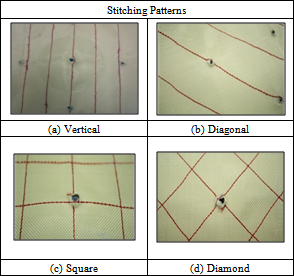 | Figure 1. Types of Stitching Patterns |
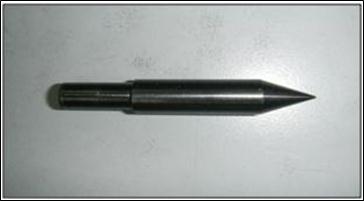 | Figure 2. Conical puncture probe |
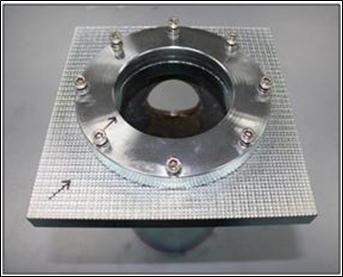 | Figure 3. Circular jig equipment |
3. Results and Discussion
3.1. Puncture Load
The results of puncture load among the stitching patterns are shown in Figure 4. It can be seen that for every stitching pattern, the puncture load increases as the number of layer increases. For the 2-layer samples, the vertical stitched pattern gave the highest puncture load. However, for the 3-layer and 4-layer samples, the diamond stitched pattern gave higher puncture load value than the other stitching patterns. 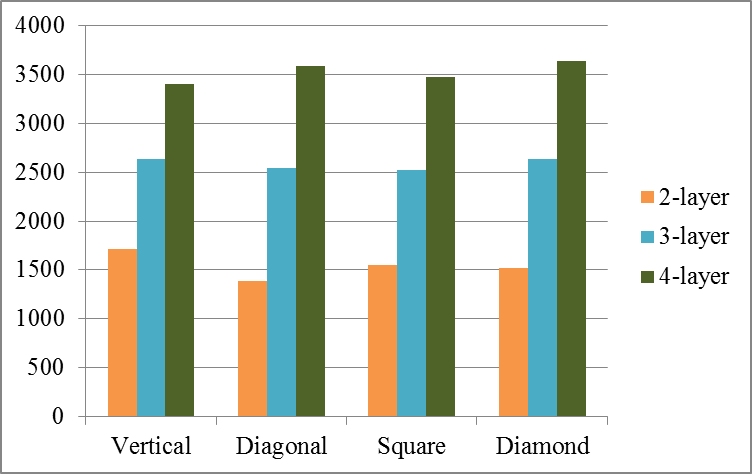 | Figure 4. Comparison of puncture load (N) |
The Duncan tests for the puncture loads are shown in Table 1 - 3 highlighting the significant differences among the stitching patterns. For the 2-layer, there are 2 groups of subset. Even though the vertical stitched pattern has the highest puncture load, but the difference is not significant with the square and diamond stitched patterns. For the 3-layer and 4-layer samples, there are only 1 group of subset. Although the diamond stitched pattern has the highest puncture load, the differences with other stitching patterns are not significant at 95% confidence interval. This may be because the penetration of the probe’s tip is only on the stitching point and not to the whole structure of the stitching patterns. Furthermore, the type of sewing thread is from the same material, which is nylon thread. Hence, the properties of the thread are similar and as a result, the yarn and the stitching pattern did not contribute much on the puncture resistance. Table 1. Duncan Test of Puncture Load for 2-Layer
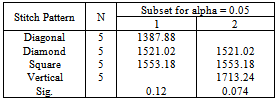 |
| |
|
Table 2. Duncan Test of Puncture Load for 3-Layer
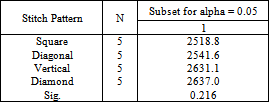 |
| |
|
Table 3. Duncan Test of Puncture Load for 4-Layer
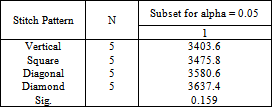 |
| |
|
The 4-layer diamond stitched pattern fabric gave the highest penetration resistance most likely because of the orientation of the stitched yarns. The samples tend to bend and stretch further when the fabrics were stitched using this type of pattern. The build-up of the strain energy and the kinetic energy by different fabric layers act as important mechanisms for absorption of the kinetic energy. The existence of stitching provides restriction to the movement of the fabric samples. Besides, the greater amount of stitching from the diamond stitched pattern also contributed to the higher puncture load. Therefore, higher forces are required to penetrate the stitched samples. This result is in accordance with the study by Ahmad et al.[14] which showed that the highest ballistic limit result was from the 2-inches field diamond stitched fabric. This result showed that stitching patterns may increase the impact energy absorbed by the soft composite fabric system.
3.2. Extensions
The comparison of extension among the stitching patterns is shown in Figure 5. For every stitching pattern, the extension increases as the number of layer increases. For the 2-layer samples, the diamond stitched pattern gave the highest extension. However, for the 3-layer stitched pattern, the vertical stitched pattern gave higher extension and for 4-layer samples, diamond stitched pattern gave the highest extension than the other stitching patterns.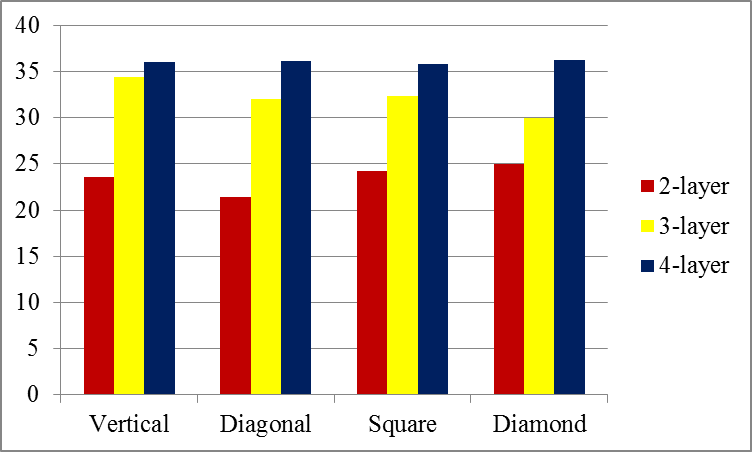 | Figure 5. Comparison of extensions (mm) |
Table 4. Duncan test extension for 2-layer
 |
| |
|
Table 5. Duncan test extension for 3-layer
 |
| |
|
Table 6. Duncan test extension for 4-layer
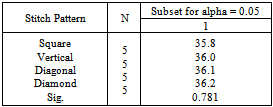 |
| |
|
The Duncan tests of extension are shown in Table 4 - 6. For 2-layer, there are 2 groups of subset. Even though diamond stitched pattern has the highest extension, but the value difference is not significant with square and vertical stitched patterns. For 3-layer, there are 2 groups of subset. Vertical stitched pattern has the highest extension but it is not significantly different with square and diagonal stitched pattern. For 4-layer, there is 1 group of subset. Diamond stitched pattern has the highest extension but the difference is not significant with other stitching patterns. According to the statistical data for extension, the values of all extensions are not significantly different with other stitching patterns. This is because the highest values obtained are slightly closer with other types of stitching patterns. The extension value determines the depth of the probe that can penetrate into the samples. By referring to the result, 4-layer diamond stitched pattern also showed the highest extension. The results of extension also showed an increment as the fabric layers increased. The increment of extension indicates the penetration resistance of the fabric. Hence, as the fabric become thicker, it can support and withstand the high load for penetration.
3.3. Mechanism of Penetration
The shape of the puncture probe also contributed to the mechanism of penetration. Nilakantan[15] et al. indicated that projectile size and shape have an important effect on the probabilistic response of fabrics. Pointed projectiles such as the conical projectiles respond in a sequence yarn failure pattern, while flatter and blunter projectiles such as the cylindrical projectiles result in a simultaneous manner of interaction and a catastrophic yarn failure pattern. The sequential yarn failures lead to more sensitivity to the strengths of individual yarns and a higher variability in response. A pointed projectile was able to push aside the primary yarns more easily at the impact site. This produces less primary yarn failure. Since the conical probe has a sharp tip, the probe has a tendency to initially stretch the fibers and the stitch yarns, followed by breaking or cutting the fibers and the stitch yarns, and completely penetrate into the fabric.Figure 6 show the top and bottom view of the penetration phase of the conical probe into the fabric samples. Figure 6 (a) and (b) show the initial stage where the sharp tip of puncture probe touched the fabric. In Figure 6 (c) and (d), the probe started to penetrate the fabric. At this point, the bending and stretching movement of yarns and fabrics occurred. The probe entered completely into the fabric in Figure 6 (e) and (f). Once the maximum puncture load obtained, the yarn and fiber breakages happened as well. The puncture load reading is dropped and the movement of puncture stopped at the final stage. Figure 6 (g) and (h) is the diagram of top and bottom view of the fabric samples after complete penetration.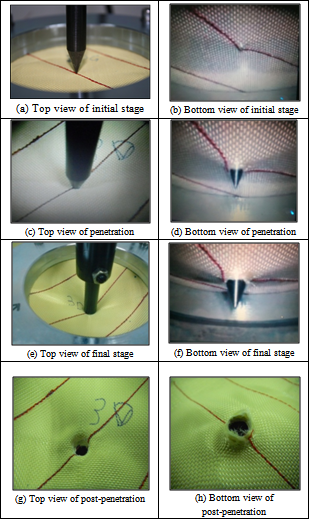 | Figure 6. Top and bottom view of the samples during several stages of penetration |
4. Conclusions
The effect of stitching patterns and additional fabric layers of Twaron fabric were studied. The puncture resistance test was conducted in order to understand the penetration behaviour. A conical shape of puncture probe was used in this study. The Twaron fabrics were stitched with four different kinds of stitching patterns which were vertical, diagonal, square and diamond pattern. From the study, the puncture loads and extensions increased as the fabric layers increased. The 4-layer diamond stitched pattern fabric showed the highest puncture load and also the highest extension. However, all the values of stitching patterns did not give any significant difference from one another. Additional fabric layers contributed to the increment of puncture resistance. It can also withstand the high load of penetration. Diamond stitched pattern contributed a better movement fabric control and has higher puncture resistance properties than other stitching patterns.
ACKNOWLEDGEMENTS
The authors would like to express great appreciation to the Research Management Institute (RMI) of Universiti Teknologi MARA (UiTM) for the Research Excellence Fund.
References
| [1] | Ong C W, Boey C W, Hixson R S, Sinibaldi J O, “Advanced layered personnel armor”, International Journal of Impact Engineering vol.38, pp.369-383, 2011. |
| [2] | Ahmad M R, Ahmad W Y W, Salleh J, Samsuri A, "Puncture resistance of high strength coated fabrics", Physics and Material Science CAS, vol.1, pp.259-263, 2006. |
| [3] | Hassim N, Ahmad M R, Ahmad W Y W, Samsuri A and Yahya M H M, "Puncture resistance of natural rubber latex unidirectional coated fabrics", Journal of Industrial Textiles, DOI: 10.1177/1528083711429144, 2011. |
| [4] | Termonia Y, "Puncture resistance of fibrous structures", International Journal of Impact Engineering vol.32, pp.1512–1520, 2004. |
| [5] | Sun B, Wang Y, Wang P, Hu H, Gu B, "Investigations of puncture behaviors of woven fabrics from finite element analyses and experimental tests", Textile Research Journal vol.81, pp.992-1007, 2011. |
| [6] | Bilisik K and Korkmaz M, "Multilayered and multidirectionally-stitched aramid woven fabric structures: experimental characterization of ballistic performance by considering the yarn pull-out test", Textile Research Journal vol.80, pp.1697–1720, 2010. |
| [7] | Karahan M, Kus A, Eren R, "An investigation into ballistic performance and energy absorption capabilities of woven aramid fabrics", International Journal of Impact Engineering vol.35, pp.499–510, 2008. |
| [8] | Sinnapoo K, Arnold L and Padhye R, “Application of wool in high-velocity ballistic protective fabrics”, Textile Research Journal, DOI: 10.1177/0040517509352517, 2009. |
| [9] | Hosur M V, Vaidya U K, Ulven C, Jeelani S, "Performance of stitched/unstitched woven carbon/epoxy composites under high velocity impact loading", Composite Structures vol.64, pp.455-466, 2004. |
| [10] | Yudhanto A, Watanabe N, Iwahori Y, Hoshi H, “The effects of stitch orientation on the tensile and open hole tension properties of carbon/epoxy plain weave laminates”, Materials and Design vol.35, pp.563–571, 2012. |
| [11] | Deng Y, Zhang W, Cao Z, “Experimental investigation on the ballistic resistance of monolithic and multi-layered plates against hemispherical-nosed projectiles impact”, Materials and Design vol.41, pp.266–281, 2012. |
| [12] | Dey S, Børvik T, Teng X, Wierzbicki T, Hopperstad O S, “On the ballistic resistance of double-layered steel plates: an experimental and numerical investigation”, International Journal of Solids and Structures vol.44, pp.6701–6723, 2007. |
| [13] | Nia A A, Hoseini G R, “Experimental study of perforation of multi-layered targets by hemispherical-nosed projectiles”, Materials and Design vol.32, pp.1057–1065, 2011. |
| [14] | Ahmad M R, Ahmad W Y W, Salleh J, Samsuri A, “Effect of fabric stitching on ballistic impact resistance of natural rubber coated fabric systems”, Materials and Design vol.29, pp.1353–1358, 2008. |
| [15] | Nilakantan G, Wetzel E D, Bogetti T A, Gillespie Jr J W, “Finite element analysis of projectile size and shape effects on the probabilistic penetration response of high strength fabrics”, Composite Structures vol.94, pp.1846–1854, 2012. |







 Abstract
Abstract Reference
Reference Full-Text PDF
Full-Text PDF Full-Text HTML
Full-Text HTML




